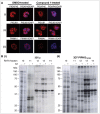Spatiotemporal and functional characterisation of the Plasmodium falciparum cGMP-dependent protein kinase
- PMID: 23139764
- PMCID: PMC3489689
- DOI: 10.1371/journal.pone.0048206
Spatiotemporal and functional characterisation of the Plasmodium falciparum cGMP-dependent protein kinase
Abstract
Signalling by 3'-5'-cyclic guanosine monophosphate (cGMP) exists in virtually all eukaryotes. In the apicomplexan parasite Plasmodium, the cGMP-dependent protein kinase (PKG) has previously been reported to play a critical role in four key stages of the life cycle. The Plasmodium falciparum isoform (PfPKG) is essential for the initiation of gametogenesis and for blood stage schizont rupture and work on the orthologue from the rodent malaria parasite P. berghei (PbPKG) has shown additional roles in ookinete differentiation and motility as well as liver stage schizont development. In the present study, PfPKG expression and subcellular location in asexual blood stages was investigated using transgenic epitope-tagged PfPKG-expressing P. falciparum parasites. In Western blotting experiments and immunofluorescence analysis (IFA), maximal PfPKG expression was detected at the late schizont stage. While IFA suggested a cytosolic location, a degree of overlap with markers of the endoplasmic reticulum (ER) was found and subcellular fractionation showed some association with the peripheral membrane fraction. This broad localisation is consistent with the notion that PfPKG, as with the mammalian orthologue, has numerous cellular substrates. This idea is further supported by the global protein phosphorylation pattern of schizonts which was substantially changed following PfPKG inhibition, suggesting a complex role for PfPKG during schizogony.
Conflict of interest statement
Figures



Similar articles
-
The malaria parasite cyclic GMP-dependent protein kinase plays a central role in blood-stage schizogony.Eukaryot Cell. 2010 Jan;9(1):37-45. doi: 10.1128/EC.00186-09. Epub 2009 Nov 13. Eukaryot Cell. 2010. PMID: 19915077 Free PMC article.
-
Characterization of Plasmodium falciparum cGMP-dependent protein kinase (PfPKG): antiparasitic activity of a PKG inhibitor.Mol Biochem Parasitol. 2006 Mar;146(1):78-88. doi: 10.1016/j.molbiopara.2005.10.020. Epub 2005 Nov 17. Mol Biochem Parasitol. 2006. PMID: 16325279
-
The role of cGMP signalling in regulating life cycle progression of Plasmodium.Microbes Infect. 2012 Aug;14(10):831-7. doi: 10.1016/j.micinf.2012.04.011. Epub 2012 May 3. Microbes Infect. 2012. PMID: 22613210 Free PMC article. Review.
-
Plasmodium falciparum Cyclic GMP-Dependent Protein Kinase Interacts with a Subunit of the Parasite Proteasome.Infect Immun. 2018 Dec 19;87(1):e00523-18. doi: 10.1128/IAI.00523-18. Print 2019 Jan. Infect Immun. 2018. PMID: 30323024 Free PMC article.
-
Cyclic nucleotide selectivity of protein kinase G isozymes.Protein Sci. 2021 Feb;30(2):316-327. doi: 10.1002/pro.4008. Epub 2020 Dec 10. Protein Sci. 2021. PMID: 33271627 Free PMC article. Review.
Cited by
-
Crystal structures of the carboxyl cGMP binding domain of the Plasmodium falciparum cGMP-dependent protein kinase reveal a novel capping triad crucial for merozoite egress.PLoS Pathog. 2015 Feb 3;11(2):e1004639. doi: 10.1371/journal.ppat.1004639. eCollection 2015 Feb. PLoS Pathog. 2015. PMID: 25646845 Free PMC article.
-
Ca2+ signals critical for egress and gametogenesis in malaria parasites depend on a multipass membrane protein that interacts with PKG.Sci Adv. 2021 Mar 24;7(13):eabe5396. doi: 10.1126/sciadv.abe5396. Print 2021 Mar. Sci Adv. 2021. PMID: 33762339 Free PMC article.
-
Plasma Membrane Association by N-Acylation Governs PKG Function in Toxoplasma gondii.mBio. 2017 May 2;8(3):e00375-17. doi: 10.1128/mBio.00375-17. mBio. 2017. PMID: 28465425 Free PMC article.
-
Cyclic nucleotide signalling in malaria parasites.Open Biol. 2017 Dec;7(12):170213. doi: 10.1098/rsob.170213. Open Biol. 2017. PMID: 29263246 Free PMC article. Review.
-
Plasmodium falciparum Guanylyl Cyclase-Alpha and the Activity of Its Appended P4-ATPase Domain Are Essential for cGMP Synthesis and Blood-Stage Egress.mBio. 2021 Jan 26;12(1):e02694-20. doi: 10.1128/mBio.02694-20. mBio. 2021. PMID: 33500341 Free PMC article.
References
-
- World Health Organization G, Switzerland (2011) World Malaria Report 2011.
-
- Murray CJ, Rosenfeld LC, Lim SS, Andrews KG, Foreman KJ, et al. (2012) Global malaria mortality between 1980 and 2010: a systematic analysis. Lancet 379: 413–431. - PubMed
-
- Bannister L, Mitchell G (2003) The ins, outs and roundabouts of malaria. Trends Parasitol 19: 209–213. - PubMed
Publication types
MeSH terms
Substances
Grants and funding
LinkOut - more resources
Full Text Sources
Molecular Biology Databases

